
The Trichiini are a tribe of the scarab beetle family (Scarabaeidae), though historically they were often classified as a subfamily, Trichiinae. The conspicuous bee beetles (Trichius) are probably the best-known genus in Europe.

Flower chafers are a group of scarab beetles comprising the subfamily Cetoniinae. Many species are diurnal and visit flowers for pollen and nectar, or to browse on the petals. Some species also feed on fruit. The group is also called fruit and flower chafers, flower beetles and flower scarabs. There are around 4,000 species, many of them still undescribed.
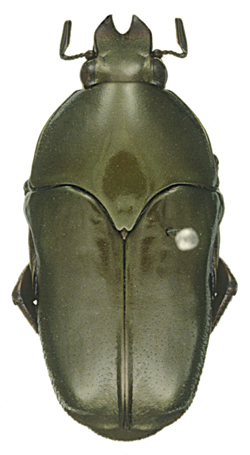
Ischiopsopha are beetles from the subfamily Cetoniinae, tribe Schizorhinini. The genus was created by Raffaello Gestro in 1874. The type species of the genus is Cetonia bifasciata Quoy & Gaimard, 1824. These cetoniids have only the tip of the scutellum visible. The genus is widespread throughout the whole Australian region.
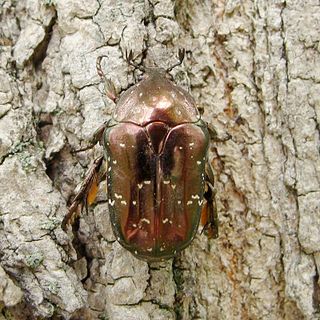
Protaetia is a genus of beetles of the family Scarabaeidae, occurring primarily in Asia, and containing over 300 species.

Trichostetha fascicularis is a large, metallic-green beetle found in South Africa.
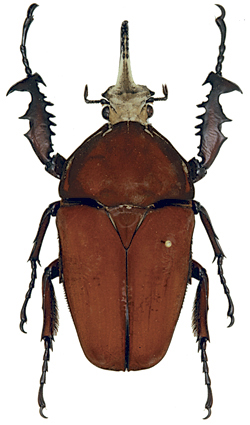
Mecynorhina are beetles from the subfamily Cetoniinae, tribe Goliathini. The genus was created by Frederick William Hope, in 1837.

Pedinorrhina cinctuta is a beetle belonging to the family Scarabaeidae.
Plaesiorrhina is a genus of fruit and flower chafers belonging to the family Scarabaeidae, subfamily Cetoniinae, found in Africa.

Rhabdotis albinigra is a species of Scarabaeidae, the dung beetle family. It was described by Hermann Burmeister in 1847.

Eudicella is a genus of small to medium beetles in the subfamily Cetoniinae, belonging to the wider family Scarabaeidae. They are distributed throughout the Afrotropical realm, including South Africa, Rwanda and Zimbabwe.

Trichostetha is a genus of beetle in the scarab beetle family. It is endemic to southern Africa, and its species most commonly occur in mountainous terrain. The genus includes several species that have only recently been described, as well as many species lacking a description of any of the larval stages. Except for T. fascicularis and its subspecies, the species comprising Trichostetha have small ranges of distribution, frequently in the Cape Floral Region of South Africa. The genus is believed to be related to Odontorrhina.
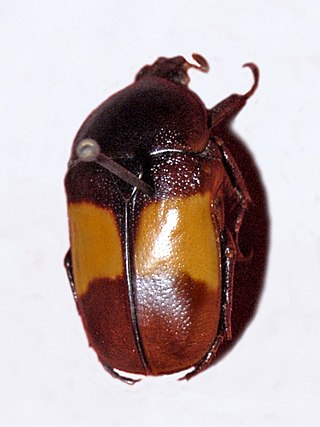
Chondrorrhina abbreviata is a species of fruit and flower chafers belonging to the family Scarabaeidae, subfamily Cetoniinae.
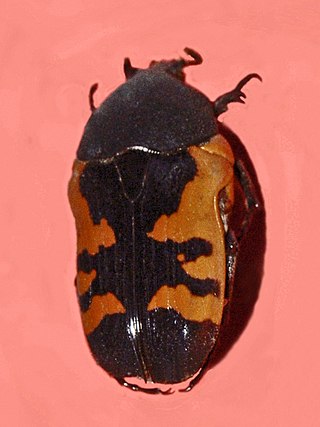
Polybaphes is a genus of fruit and flower chafers belonging to the family Scarabaeidae, subfamily Cetoniinae.

Xeloma are beetles from the subfamily Cetoniinae, tribe Cetoniini. The genus contains thirteen recognised species found in various countries of Sub-Saharan Africa.
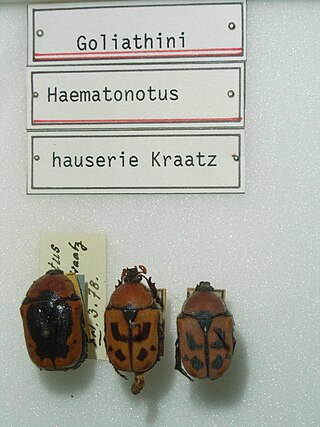
Rhinocoeta is a genus of colorful beetles belonging to the subfamily Cetoniinae, family Scarabaeidae.

Cremastocheilini is a tribe of scarab beetles in the family Scarabaeidae. There are about 50 genera in the tribe Cremastocheilini.

Cetoniini is a tribe of fruit and flower chafers in the family of beetles known as Scarabaeidae. There are over 80 genera in Cetoniini, found worldwide.

Odontorrhina is a genus of flower chafer beetles comprising four species and two subspecies. The bodies of all species are heavily covered with small bristles (setae), and they are believed to be most closely related to the genus Trichostetha. Members of the genus have been recorded exclusively from the South African provinces of the Northern and Western Cape, aside from one unconfirmed record from southern Namibia. They are endemic to the Fynbos and Succulent Karoo regions.
Pedinorrhina is a genus of fruit and flower chafers belonging to the family Scarabaeidae, subfamily Cetoniinae, found in Africa.


















